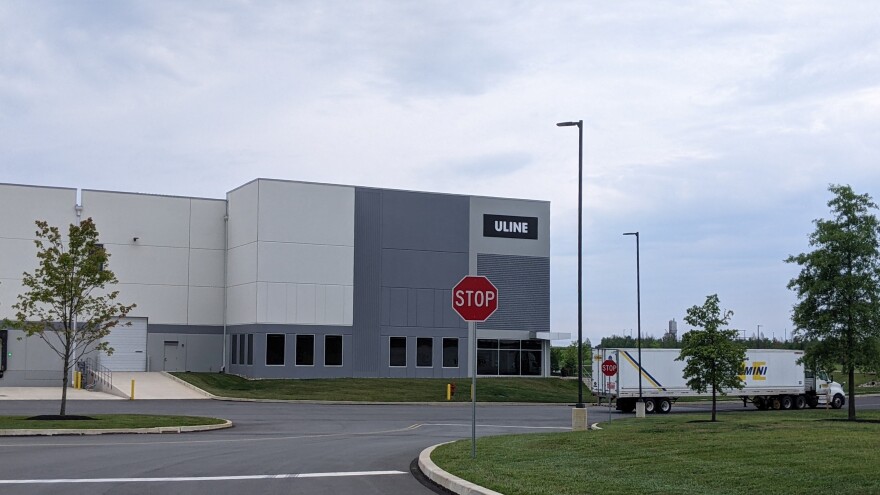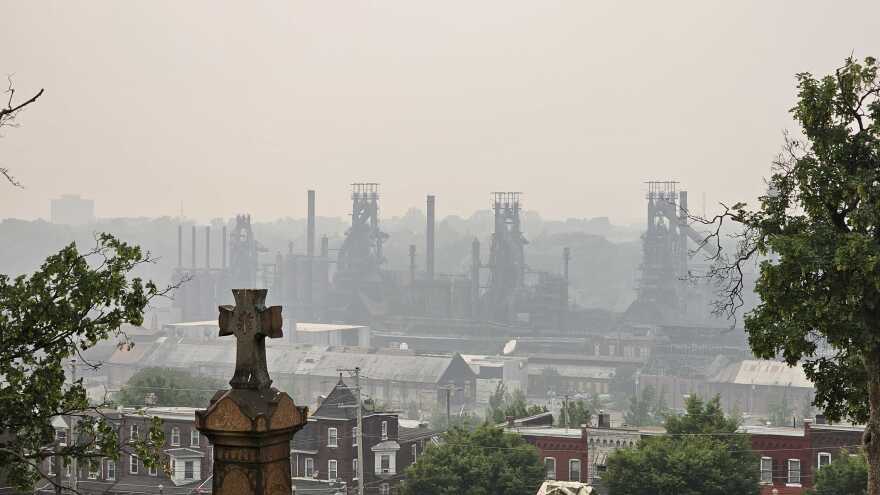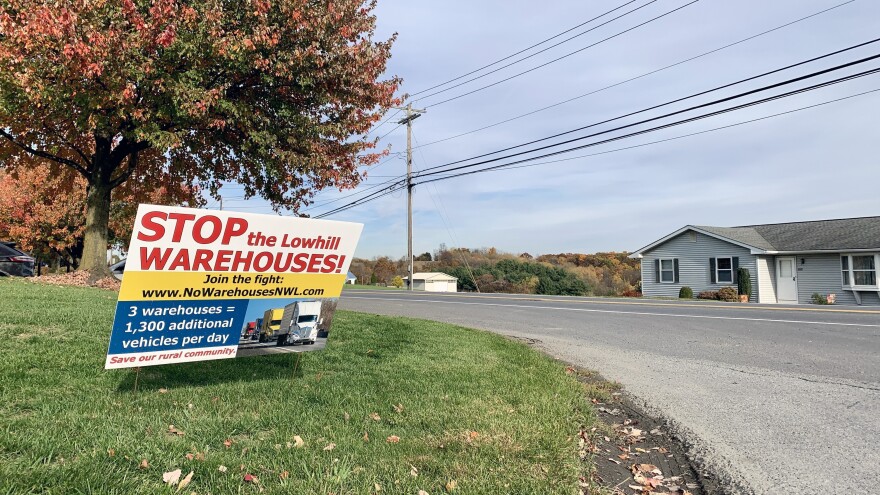MORE: In search of balance between economic growth and too many warehouses
TATAMY, Pa. — When Chris Moren moved to the borough in 1997, no mailboxes dotted the streets.
Instead, each resident in the eight-block-wide, blink-and-you’ll-miss-it Northampton County municipality had their own post office box.
“This [housing] development came in and they put mailboxes up,” said Moren, who from 2018 to 2022 served as the borough’s mayor, gesturing out the window of his pickup truck during a recent tour.
It only took minutes to reach the municipality’s boundary lines on all sides – it’s surrounded by warehouses, development and ongoing construction.
“More and more people started putting mailboxes up … Saturday morning at the Tatamy post office was a big deal. If you wanted to talk to your neighbors and catch up on what was going on, you went to the post office on Saturday.”
Now, it’s like the culture of the community has “entirely” changed, he said.
“That's gone now. There are a few people who continue to go down there, but the majority of us — I see them more and more every day — are putting mailboxes up.”
While Tatamy is one example, it isn’t unique.
The Lehigh Valley has been reshaped by a massive wave of development, both industrial and residential, that has swept over the region the last three decades.
In just the past five years, about 23 million square feet of warehousing was proposed but has yet to get through the approval process.
That's in addition to the 44 million square feet of industrial and warehouse space approved in Lehigh and Northampton counties in the last nine years, according to the Lehigh Valley Planning Commission. That amount alone is equivalent to more than 1,000 acres.
While the development boom — it elevated the Lehigh Valley to a record $50.2 billion in gross domestic product — may be finally slowing, the impacts to the region’s economy and the environment are clear.
Increased truck traffic has tainted the air, and impermeable surfaces have contributed to runoff and flooding – and that’s not considering climate change, which scientists say continues to drive temperatures higher year over year, worsening the impacts of human activity.
“This used to be a farm field,” Moren said, looking out at the construction underway between Tatamy and the Route 33 interchange in Palmer Township. “We would watch the sunset out here.
“It's just not the same anymore.”
However, alongside the negative effects the warehousing and logistics boom have had on the environment and the culture of the Valley’s communities, it’s been good for business — as well as the employees and infrastructure it's dependent on.
I sometimes think that we worry a little bit about this mythical dream of untouched land. Obviously, you don't want to pollute the waters and affect the climate or affect breathing, but a [distribution center] isn't doing any of those things. And I think it's bringing in valuable jobs.Zach G. Zacharia, an associate professor of supply chain management at Lehigh University.
“I continue to believe that there's going to be more growth,” said Zach G. Zacharia, an associate professor of supply chain management at Lehigh University. “If you don't have jobs, I think that's a real problem.
“ … I sometimes think that we worry a little bit about this mythical dream of untouched land. Obviously, you don't want to pollute the waters and affect the climate or affect breathing, but a [distribution center] isn't doing any of those things. And I think it's bringing in valuable jobs.”
How did we get here?
Nestlé was one of the first to build a large warehouse in the Valley, off Interstate 78 in Upper Macungie Township. At 100,050 square feet, it was quite a feat in the early 1990s.
“We proudly distribute over 1,300 unique items through food service providers, retail and eCommerce channels,” a Nestlé spokesperson said in an email. “While we have been in the community since 1994, we look forward to celebrating 30 years in the Lehigh Valley by developing new partnerships and strengthening the ones we already have.”
Dennis Toman, of New Tripoli, has been employed at Nestlé from its opening. He remembers officials chose to build in the Valley because it was adjacent to so many “opportunistic transportation routes.”
“Nestlé gave me an opportunity when I only had six months of experience,” said Toman. “They took a chance on me 30 years ago and now I am a supervisor and get to give back.”
Those transportation routes, including highways and interstates, make the Valley a prime location for logistics, simply because of its proximity to so much of the country’s population.
The Valley is within a day’s drive of one-third of the U.S. population, has an international airport and freight rail access, and is within 100 miles of the Port of New Jersey and New York, and the Port of Philadelphia.
While Nestlé was one of the first, it was certainly not the last. Warehouses began cropping up at a dizzying rate across the region as business owners sought not only the location, but were incentivized by cheaper costs, both for labor and land.
And, as developers moved in, the roads had to be improved to handle the influx of truck traffic.
“They have to do that because they want to make it convenient and safe for large trucks to go through, so they do actually invest in the infrastructure,” said Zacharia, who also serves as director of the Center for Supply Chain Research at Lehigh. “They have to widen the roads. They have to increase the sight distance. They have to fortify the bridges.
“They do invest in that in the area.”
Two words can sum up the reason why the Lehigh Valley became a hotspot for logistics and warehousing, PennFuture attorney Brigitte Meyer said — the internet. The “World Wide Web” entered the public domain in April 1993, and the COVID-19 pandemic decades later only exacerbated e-commerce.
“Retailers made it possible to order goods online so that you don't have to go to a brick-and-mortar store,” Meyer said. “And, now, there’s this entirely new sort of model of direct-to-consumer shipping.”
Traditionally, warehouses acted as long-term storage facilities, feeding brick-and-mortar stores. However, as consumer habits changed, so, too, had warehouses.
“With the advent of e-commerce, it shifted from long-term storage of goods for these retailers, to sort of, rapid in-and-out distribution directly to consumers,” Meyer said. “So, now the focus is putting a very large quantity and sort of varied goods into one place and making it so that you can take the goods in and out of that facility very quickly and get it directly to the individual consumer.”
The Valley had everything developers were looking for, Meyer said, from cheap, available land to plentiful labor.
“There is an available workforce in the Lehigh Valley, particularly with low unionization,” she said. “Developers don't want to pay union wages.”
Plus, outdated municipal codes hadn’t caught up to the reality of modern development.
“The municipal ordinance structure wasn't ready for this,” Meyer said, explaining the mechanism for control is almost entirely at the local municipal land use ordinance level, with guidelines set by the state.
“The issue, especially early on in Lehigh Valley, was that this was a pretty new type of development — nobody had seen a 1.5 million-square-foot Amazon fulfillment center in 1968 when a lot of these zoning ordinances were drafted,” Meyer said. “And so, when this started happening, and even now, municipalities, even though they have the power to put like a lot of guardrails around this and control where it is, how it's done, they were just kind of caught unaware and didn't have those things in place when the developers showed up and said, ‘Here's my plan.’”
A parade of warehouses soon followed: Amazon, FedEx, Keurig Dr. Pepper, ShopRite, Dial, Coca-Cola, Bridgestone, Home Depot and more.

While it might seem that warehousing is relatively new for the Valley, commercial storage has been part of the region for a century.
“We have had a very important role in the industrial history of America, even before Bethlehem Steel with the canal system, which was revolutionary and getting wood and coal and feathers and pelts and all kinds of stuff to Philadelphia and then eventually into New Jersey and even into New York in the early 1800s,” said Becky A. Bradley, executive director of the Lehigh Valley Planning Commission. “We've been very active in industrial overall and anytime you have industrial, you have multiple pieces of it.
“It's everything from the manufacturing, or quarrying in the case of the cement industry, or other things. You're going to have a storage component as part of that.”
But, while the function of warehouses might have stayed the same, the form hasn’t. They keep getting bigger.
“Technology, and materials, have actually allowed the buildings to get bigger, but they tend to be just big boxes, big rectangles,” Bradley said. “They are very flexible inside and many, many of them have more than one use, but you can't tell, because they don't have windows that you can look in all the way around like you would, maybe, in an older manufacturing facility that needed the windows to let in fresh air.
“Everyone just calls them warehouses, though,” she continued. “They may be — they may just be storing goods, but they could be doing a whole host of other things. But, some storage component is always inherent in the manufacturing process.”
Before warehouses overtook the landscape, farmland was being replaced with communities of smaller boxes — single-family housing developments.
“That was the competition for the farmland up until eight, nine years ago,” Bradley said. “And then, with that housing downturn in the mid-2000s, then it really switched over to industrial.
“Those are much larger, very obvious buildings, where a housing development is also obvious but in a different way.”
Currently, there’s 72 square miles of preserved farmland in the Valley. Through the state’s Farmland Preservation Program, farmers sell their development rights to the state’s State Land Preservation Board, protecting the land from any future residential or commercial development.

What has been affected?
When it comes to environmental impacts, it’s helpful to be able to “point and say there,” said Donna Kohut, a PennFuture campaign manager.
“It's not as if we had a factory on the bank of the Lehigh River that was spewing toxins through a culvert directly into the river. You can point and say, ‘That's bad. That's pollution. You're killing the river,’” Kohut said. “With this kind of development, especially since it is, in some areas it's concentrated, in other areas, it's much more spread out … it's hard to point and say there, but when you look at the amount of truck traffic that increases, there's more diesel fuel in the air, that means there's more particulate matter in the air.
“The Lehigh Valley already has some of the worst air quality in the United States, and so, adding more of this particulate matter and diesel fuel, especially to more vulnerable communities, historically disadvantaged communities like folks in Allentown, low-income folks, you're going to see the increase in issues, especially things like asthma.
“You're going to see negative health outcomes increase, but I can't point to that one truck and say that one truck is doing it, because it's an accumulation of air pollution.”
Air quality has deteriorated so greatly around the region that last year Allentown was named the asthma capital of the U.S. by the Asthma and Allergy Foundation of America, climbing from third place the year prior.
A month before the rankings were released, and two months after smoke from Canadian wildfires blew into the region, choking residents, officials from both Lehigh and Northampton counties launched Lehigh Valley Breathes, a year-long project aiming to monitor air quality amid emissions from trucking and warehousing.

Poor air quality is driving residents away, officials argue, and the monitoring project will give leaders data to improve the air and combat further issues.
Almost a year into the project, officials have released some preliminary findings, including that fine particle pollution, also called PM 2.5, is highest near warehouses and highways.
The Environmental Protection Agency earlier this year also released new standards for PM 2.5.
PM 2.5 are particles so small that they’re invisible to the naked eye, but are made up of a mix of chemicals that can get deep into the lungs and can cause health problems.
Just like with air, pollution also accumulates in water.
“What comes with these large industrial developments is the impervious surface: your pavement, your roads, your roofs,” Kohut said. “When you have a rain event, having all of that impervious surface literally changes the way that the water flows over the land, and so you've got a higher volume and a higher velocity of stormwater runoff, which does a bunch of things.
“It can increase flooding, because the water is not being soaked up or slowed down and inundated and overwhelmed or creeks. streams, rivers – whatever wetlands are left.”
Water temperature can also increase, negatively affecting aquatic wildlife, like native trout populations. Erosion and sediment can build up in the waterways.
Last April, the Lehigh River was included on a list of endangered rivers across the U.S. Officials at American Rivers, a national nonprofit focused on clean water and river health, says the Lehigh is threatened by “poorly planned development” of warehouses and distribution centers.

A few months later, the state Department of Environmental Protection and the U.S. Geological Survey released the results of a 2019 survey studying the prevalence and distribution of per- and polyfluoroalkyl substances, or PFAS, in surface waters across the commonwealth. Of the 161 streams tested — including four in the Valley — 76% contained at least one type of PFAS.
“The way that it's set up is we look at these projects individually,” Kohut said, detailing clear benefits to warehousing development, like increases in jobs or additions to a community’s tax base. “But we don't look at them as they accumulate over the entire community.”
The EPA in mid-April set new, stricter limits on PFAS in drinking water.
What’s next?
As Moren drove loops around tiny Tatamy, he shared memories.
“This building over here, I used to bring my kids when they were little and we would come here and get our milk and then pet the cows,” Moren said. “That's what we did. Now, it's [a paving materials supplier].
“And the cows are gone.”
Where there was once farmland surrounding the borough are warehouses, housing developments and gas stations. As warehouses and distribution centers moved into neighboring townships, like Palmer, officials quickly realized the borough would feel all the headaches without reaping any of the benefits.
“We get traffic. We get noise,” said Borough Manager Mark A. Saginario. “We get our police department stretched like you wouldn't believe.”
The borough’s “little Main Street” has become inundated by trucks.
“There are some homes from when Tatamy was created 125 years ago,” said Mayor James Pallante. “The truck traffic is noisy, it vibrates their house. They say their foundations are cracking. Some of this area wasn't meant for that.”
Where there was once only a blinking light at a four-way intersection that served as the gateway to Tatamy, there is now a bustling intersection. The blinking light has been saved, preserved by the borough’s historical society — a piece of the past to tie the borough to its roots.
Now, it’s all about accountability and communication, Moren said, especially as residents often become entrenched in their views or stances, including when it comes to land development.
“The community hates the developer. They hate the project. They hate everything about it. They don't want it. They don't need it. We were fine without it … ” Moren said. “But it's our responsibility as community leaders to try to bridge that gap.
“At the end of the day, try to make everybody happy — and that's not always easy to do.”
COMING TOMORROW: BACK TO THE BEGINNING
Thirty years ago, the Trexlertown and Fogelsville areas of Upper Macungie Township became ground zero for the change that was rapidly coming to the Lehigh Valley. Perhaps no community in the region has had better experience managing the warehouse and industrial building boom — and trying to balance it.





